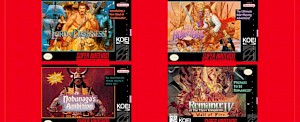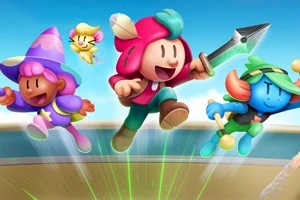All N64 Games #151: The Legend of Zelda: Ocarina of Time
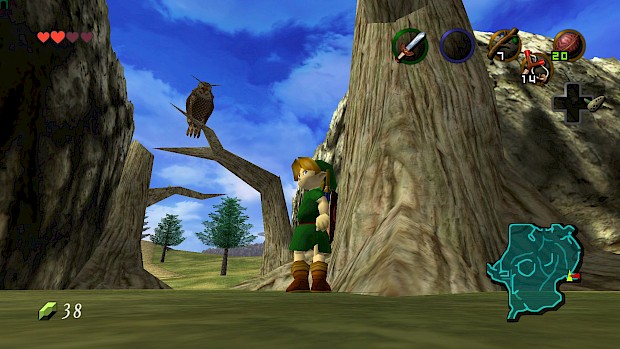
Posted 13 Aug 2024 at 10:42 by Dean Jones
Often heralded as one of the greatest games of all time, I really don’t need to go into great detail as to what makes Ocarina of Time so amazing, as it provided one of the first epic adventures in 3D in a way that felt real. For this, I played a fan made PC port of the game that is a very faithful recreation. I used a few enhancements, such as camera control and the ability to assign items to the D-pad, plus a texture pack which added detail but still kept the feel of the N64 original.
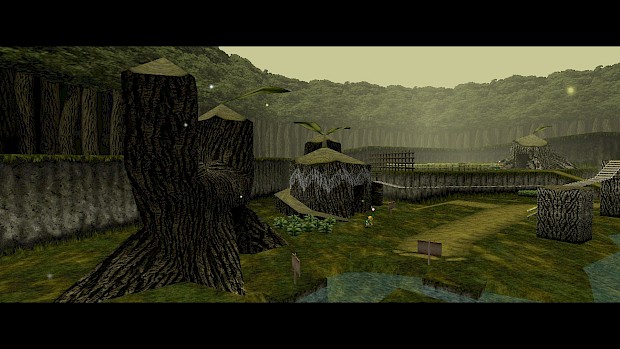
The game starts out in Kokiri Forest, which serves as a tutorial hub that manages to not feel like a tutorial. This is a small playground that lets you play with aspects of the game’s control and targeting systems, the context sensitive A-button, but all the lessons are completely optional and are for the player to find. This kind of discovery was a great feeling as a kid, and the starting area is designed in such a way that if you know what you’re doing, you can very quickly grab your sword and shield and get on with the game.
I feel like Kokiri Forest is overlooked for how well it introduces Ocarina of Time, as a lot of the stuff is now just second nature in video games, but Ocarina had to teach everything from scratch. Even simple things like pots respawning to collect more rupees is taught by the rarity of rupees and the need to buy the Deku Shield, and the little pond areas introduce how jumping is done in the game.
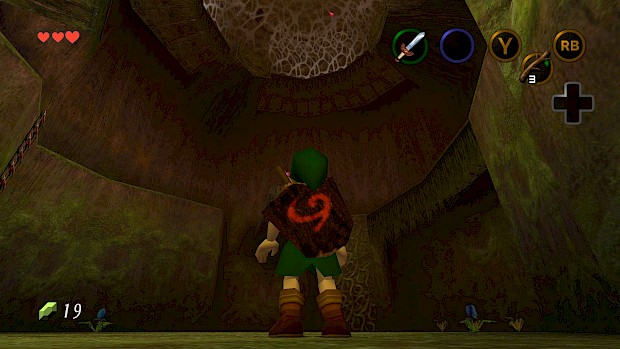
Dungeons are a big part of Ocarina of Time, and the game eases you into them with the Deku Tree, while also showing off the verticality possible thanks to the N64’s power. There are a few little tricks like trapping you in the slingshot room until you use it. Unfortunately, Navi does decide to butt in by explaining specific actions like moving blocks and diving, running the freedom of the starting village, but as you the action for interacting with a block changes based on if you’re still and moving, I can see people missing one of the actions and getting stuck.
The game directs you upwards to perform a big jump to get to the lower areas of the tree, and uses deku sticks to activate torches and remove obstacles, showing the kind of ways that you can interact with in the game.

After the Deku Tree, we get a significant gap until the next dungeon as the game opens up to a large expansive world, a technique still used in games today. You’ll be directed towards the castle by a really annoying owl (with confusing did you not hear me or did you not not hear me? yes or no questions), but the size of Hyrule Field is specifically designed that (without knowing the way and rolling to move faster) night will fall, a way to introduce how time works in the game, and how it moves in certain areas.
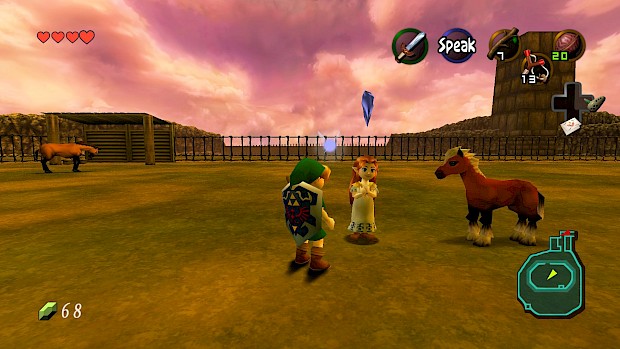
Castle Town is filled with NPCs to talk to and side quests that are hinted at for you to start later on – although first is the obligatory stealth section, but with a fixed camera to make it easier (was Ocarina of Time the start of the forced stealth section trend?), where you’ll meet Zelda as you learn the quest of the game. Once the “main” quest starts, you need to start figuring out things yourself, with the first big hurdle figuring out what to actually do in Goron City, which is likely where a lot of kids got stuck for a while, as the solution lies in revisiting somewhere across the map.
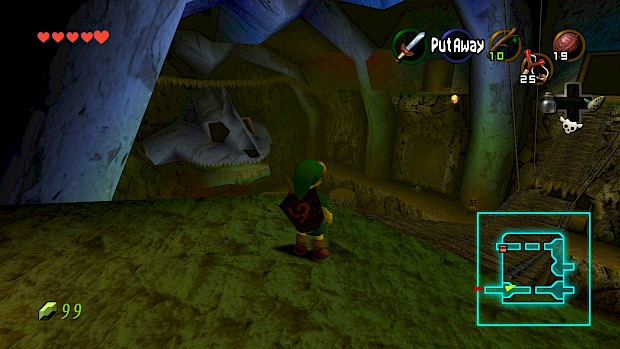
Dodongo’s Cavern waits to introduce its name until you reach the main central room. Here you can see a lot of paths, both on the current level and upstairs, but this guides you far less than the deku tree as you have to figure out how to navigate the dungeon yourself. It also presents an added danger as your deku shield can be destroyed by fire enemies – you are no longer in a kid’s world, and this dungeon does a great job at portraying that.
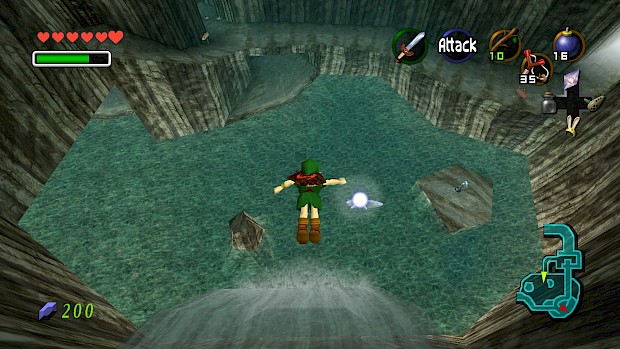
After this, you have access to even more of the world, as you’re directed to Zora’s Domain. You also get introduced to magic beans, which let you plant in patches of soft dirt – they’ll take years to grow, so this is the first in-game hint as to what will happen later on. Zora’s Domain also teaches you about bottles (although if you do side missions, you can get some before here), which are used to collect certain items for later on, as well as letting you carry a fairy to revive Link. You also need to go to Lake Hylia, where you can find the wonderful fishing minigame.
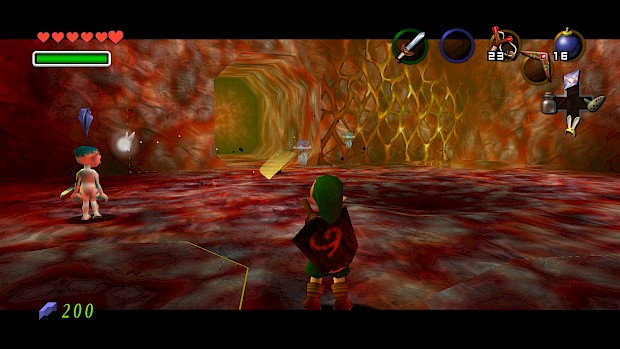
After solving the puzzle to get inside Lord Jabu-Jabu, you enter the next dungeon with pulsating walls and dangerous electric jellyfish. This one is very difficult to navigate first time round, and you have to use Ruto to activate switches as she accompanies you for part of this dungeon – a concept revisited in Wind Waker. I like the style of this dungeon, but it’s definitely my least favourite.
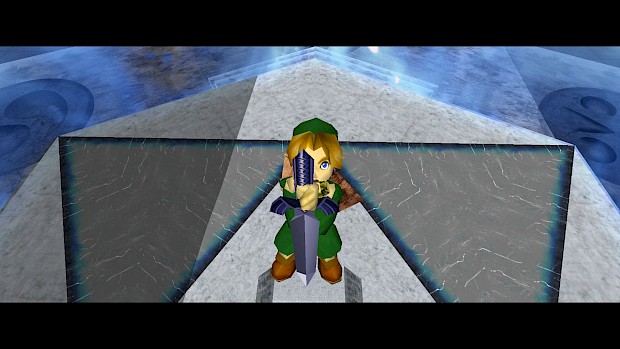
With all three spiritual stones in hand, you head to the Temple of Time – grabbing the Ocarina of Time from the fleeing Princess Zelda along the way as Link gets hold of the Master Sword, only to wake up after 7 years in slumber. He’s now an adult, and the world outside is much darker, with a destroyed Hyrule Market overrun by Zombies. A mysterious new character, Shiek, is on hand to guide Link towards the temples he needs to visit to awaken the sages of the land.
You get directed to Kakariko Village, where you need to use clues given by NPCs to find one of the coolest objects in the game – the hookshot.
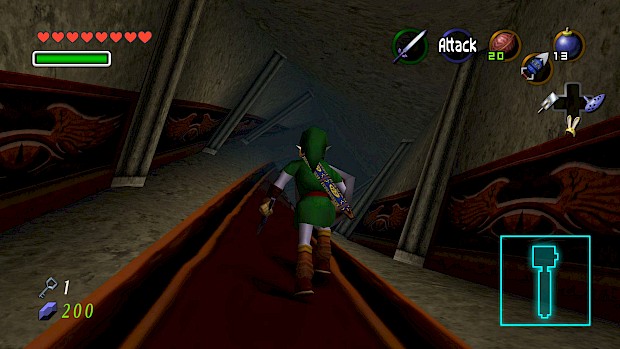
The Forest Temple is the first dungeon as an adult, and has some very unnerving music (the music is amazing across the entire game) and some really neat ideas of manipulating the dungeon itself – something else that would be revisited in more detail in future Zelda games. Here you get the adult equivalent of the slingshot, the bow and arrow. It’s a very unnerving dungeon, and ends with a practice for the final boss of the game.
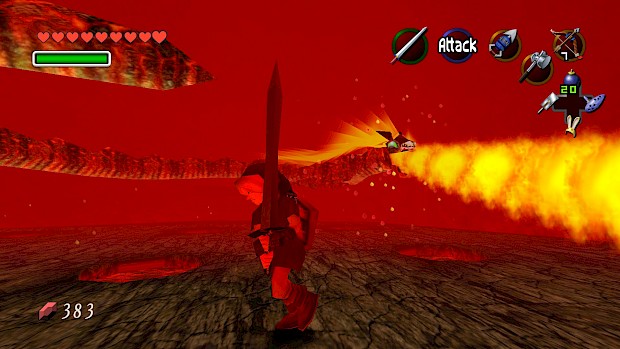
You can do the temples in different orders, although some optional areas may be locked off – the map for the fire temple, for example, needs the bow. The fire temple also needs a special tunic that you need to get first (although people have completed the dungeon without it), here you get the Megaton Hammer, which is used to activate rusty switches and smash harder rocks, before fighting a fire-breathing dragon. I like to use the Giant’s Knife here, which is a powerful sword that can only last a few hits (a permanent one is a reward for one of the longer side quests of the game).
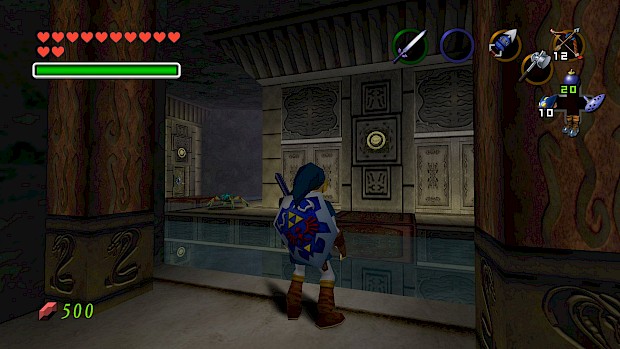
The Water Temple has a really bad reputation, and I can see why. It’s not as outrageously hard as its reputation, but it does a few things differently. The biggest difference is how it treats small keys. Usually they’re on the way to close to the locked door they’re needed for, but the Water Temple is a bit more open ended, with keys hidden all over the place. One in particular (under the central room) is very easy to miss. You also need to change the water level a lot, so exploring it can be a faff. Lastly, the iron boots needed to be constantly equipped and removed, and could only be done so from the pause menu (luckily the version I played, like the 3DS version, lets you assign it to an item button).
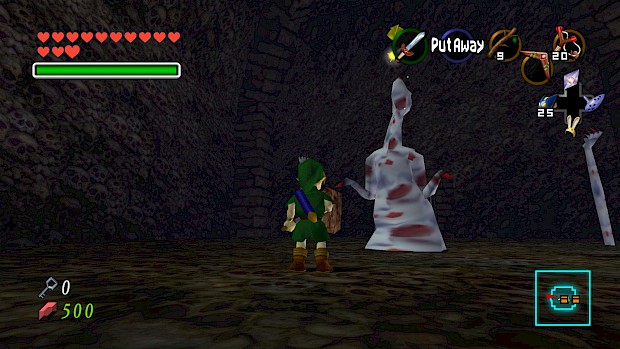
Eventually, you’ll be unable to progress as adult Link and will have to return to the past as child Link – something alluded to by the man in the Windmill complaining about someone playing a song on the ocarina in the past (and then teaching you the song, which you will then teach him in the past). The game ups the horror vibes a lot and, if you wait until this point to go back in time and head to the well, you’ll also feel much more vulnerable due to not having access to a lot of your items. This is to get the Lens of Truth, needed for the Shadow Temple (technically you can do it without, but you need to know the game extremely well).
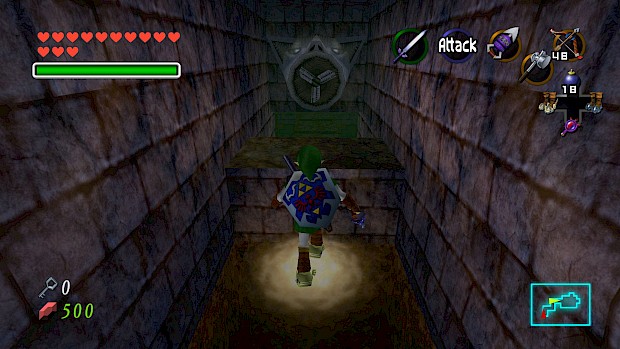
With lots of creepy vibes and invisible enemies and objects, the Shadow Temple really freaked me out as a kid – to the point that I backed out after getting the hover boots and did the Spirit Temple, and I even stopped playing the game, only returning after completing Majora’s Mask years later. It seems really tame now as I know what to expect, but the unknown really was too much for me back then. This temple – and the next – are much more linear, although with really fun bosses.
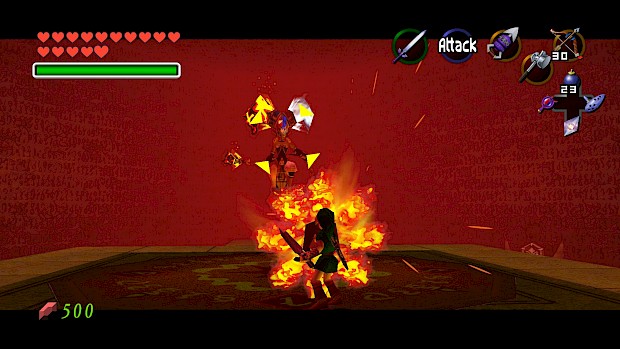
The Spirit Temple is fascinating as it needs to be completed in two parts – one half as a kid and the other as an adult. You get a really nice shield which is used to reflect light and certain attacks and, like a few other items from the adult dungeons, it’s a shame it doesn’t have much use elsewhere in the game.
After this, you then have access to the final dungeon, which consists of mini challenges loosely based on the various temples, before you take on Ganondorf. Of course, there are still side quests to complete.
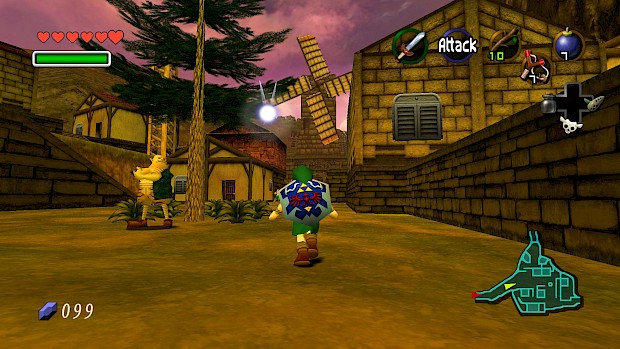
The hunt for heart pieces is the most significant kind of collectible, but the trading and mask side quests are also great. Hidden throughout the land are also 100 Gold Skulltulas, many of which only appear at night. The rewards for the first 50 are pretty good: bigger wallets, a heart piece and a special stone that rumbles when you’re near a secret. The final 50 only grants you 200 rupees which, while you can collect it multiple times, is completely pointless at that point in the game as you’ll spend most of the game with a full wallet anyway. A gold coloured tunic would have been a better option (perhaps it can have protection for fire and water so you don’t need to change tunics).
The lack of things to use money for is probably one of the bigger weaknesses of the game. The dungeons and overworld have bonus puzzles, most leading to money or the Gold Skulltulas. It feels like a waste when the reward you get is completely pointless, but that’s only a minor issue.
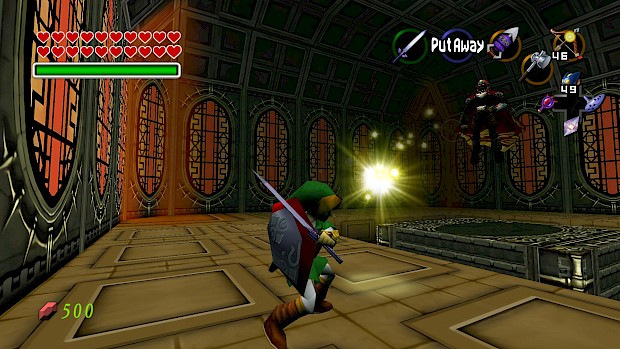
Ocarina of Time is still a wonderful game. The world does feel a bit small by today’s standards, but for its time, it was phenomenal, and in many ways, Ocarina of Time showed how 3D adventures could and should be done. It’s an important piece of video game history that is still great to play today.

Fave
An American journalist has already described Ocarina of Time as “the Gone With the Wind” of videogames. It is not only that, but also the Guernica, the War and Peace, the Citizen Kane. Think of Super Mario 64 – as toweringly brilliant as it is – as a mere sketch, a character study; this is the completed picture, a portrait so exquisite it will be puzzles over, studied and, most of all, enjoyed for years. Nothing else comes close. Game of the century? Believe it.
Jes Bickham, N64 Magazine #24. Review Score: 98%
Remake or remaster?
Something similar to what the fan PC port offers would be lovely for Ocarina of Time, combined with some of the enhancements of the 3DS version.
Official Ways to get the game
There is no way to buy a new copy of The Legend of Zelda: Ocarina of Time, the only official way to play is to rent it via the Nintendo Switch Online + Expansion Pak.
Re-releases
2002: The Legend of Zelda: Ocarina of Time Master Quest (GameCube)
2003: The Legend of Zelda: Collector’s Edition
2007: Wii Virtual Console
2011: The Legend of Zelda: Ocarina of Time 3D (3DS)
2015: Wii U Virtual Console
2021: Nintendo Switch Online (Subscription Only)



